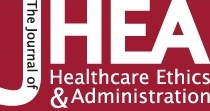We Welcome Latest
Research
Articles in
Field of
Medicine, Ethics and Healthcare Administration

About the Journal
The Journal of Healthcare Ethics & Administration (JHEA) is an international open-access online journal that reflects the issues on medicine and healthcare administration. The JHEA welcomes original researches, review articles and case studies by scholars, medical and law professionals, and healthcare administrators who desire to share knowledge through the dissemination of published works. Each published article in the journal is approved by an international editorial board before publication using a double-blind, peer-review process.
Currrent Issue Vol.11 No. 2 (Spring 2025)
Pages: 1-7
In this paper, I delve into the moral challenges facing the American healthcare system, recently highlighted by the tragic murder of UnitedHealthcare CEO Brian Thompson. Through the lens of moral economy, I discuss how the profit-driven nature of healthcare organizations often overshadows the fundamental purpose of patient care, sparking public outrage and demands for change. Recognizing the need for a shift, this paper emphasizes how healthcare management education (healthcare administration education, interchangeably) can play a pivotal role in shaping future leaders. By integrating moral economy principles into curricula, we can better prepare students to navigate the complex healthcare landscape with integrity and compassion. I propose several approachable teaching strategies, such as using real-world case studies to illustrate ethical dilemmas, fostering empathy through community partnerships, and encouraging open discussions about corporate responsibilities in healthcare. By adopting these practices, educators can inspire students to advocate for a healthcare system that prioritizes compassion, fairness, and accountability. Ultimately, this paper calls for a renewed commitment within healthcare management education to uphold the moral obligations intrinsic to the profession. By doing so, we can reinforce the commitment to healing and service that lies at the heart of the commonwealth, empowering the next generation of healthcare leaders to effect meaningful change.
- Harshil Patel, Fredy J. Abboud, Peter A. Clark, Shikha Patel, Kreena Patel, Jeremy Muhr, Benjamin Gabrieliants, Andren Chen, Dominic Zaffino, Jose Dubon
Pages: 8-21
For more than a decade, cities struck with substance-use disorder have experienced the brunt of clandestinely adulterated drugs circulating the streets, culminating in the tragic death of over 107,000 individuals by drug-overdose in the United States in 2022. Recently, those cities, particularly Philadelphia, have witnessed a new “wave” of drug-adulterants entering the illicit drug supply. In May 2024, medetomidine, a non-opioid sedative employed in veterinary medicine, was identified as a new drug-contaminant in Philadelphia, with most identified medetomidine being co-detected with either fentanyl or xylazine. Medetomidine’s long-term effects on humans remain unknown, as concerns of a worsening illicit substance-use epidemic grow. Given such fears, this article serves to briefly educate readers on the current pharmacological and medical knowledge of medetomidine and its possible ramifications on the illicit substance-use epidemic, to offer recommendations to combat the early spread of the drug, and to ground our recommendations in ethics.
Issue Vol.11 No.1 (Winter 2025)
- Brenda Ayala
Address correspondence to: Brenda Ayala. MSHA Student. VCU College of Health Professions. Richmond, VA 23298. Email: Brayala@vcu.edu
Pages: 1-6
The chronic shortage of healthcare workers presents significant ethical and legal challenges, particularly regarding the quality of patient care and safety. This paper explores the implications of healthcare worker shortages, focusing on their impact on labor cost, compromised patient care, increased medical errors, and rising malpractice claims. Healthcare institutions face legal risks when they fail to meet mandated staffing ratios, which can result in penalties, fines, and lawsuits. Furthermore, overworked staff, often subject to extended hours and excessive workloads, raise concerns about labor law violations, including non-compliance with mandatory rest periods and fair overtime compensation. The increased reliance on contract workers to fill staffing gaps also introduces legal challenges related to contract disputes, working conditions, and patient safety. Addressing these shortages is critical to preventing further harm to patients and mitigating legal liabilities for healthcare systems. This paper proposes a set of solutions, including legal mandates for minimum staffing ratios in critical care areas and incentives for recruitment and retention in underserved regions. These measures aim to reduce turnover, protect patient safety, and minimize legal risks. A holistic approach to workforce planning and policy reform is necessary to sustain safe staffing levels and ensure ethical standards of care are maintained across the healthcare system. Ultimately, addressing healthcare worker shortages is both a legal requirement and an ethical imperative to safeguard the future of patient care and the well-being of healthcare professionals.
Issue Vol.10 No.3 (Fall 2024)
- Akshara Reghunath K, MBE.
Address correspondence to: Akshara Reghunath K. Masters in Bioethics (MBE). ICREP, CUSAT, KOCHI. Ernakulam, Kerala. Email: aksharareghunath1999@gmail.com
Pages: 1-16
Robotic surgery has come to light as an innovative advance in medicine that has drastically changed the face of healthcare. Patients can benefit from this technology’s unparalleled precision, control, and minimally invasive choices to its integration of sophisticated robotics, artificial intelligence, and accurate surgical methods. With the use of robotic devices, surgeons may now conduct difficult procedures with increased accuracy, less trauma, and quicker recovery times. Shorter hospital stays and reduced complication rates are the results of this better patient outcome. The article examines the development of robotic surgery, its present uses in a range of medical specialties, and its effects on patient care and the larger healthcare system. It also addresses the difficulties and prospects for robotic surgery in the future, particularly how it might be integrated with cutting-edge innovations like telemedicine and machine learning, which have the potential to completely transform the surgical field. This analysis highlights how robotic surgery can change healthcare delivery and improve patient outcomes. It also shows how robotic surgery has the potential to become a new norm in modern medicine.
- Daniel C. Eisner, DMSc, MHA, PA-C, CPHQ
Address correspondence to: Daniel C. Eisner, DMSc, MHA, PA-C, CPHQ. E-mail: email.eisner@gmail.com
Pages: 17-25
OBJECTIVE: This narrative review explores concerns and potential solutions for improving the quality of synchronous telemedicine visits for high utilizers like primary care, particularly after the COVID-19 pandemic. METHODS: A literature review identified studies published within the past 10 years focusing on telemedicine quality, primary care, and related aspects like liability, virtual exams, and patient safety. RESULTS: Despite the surge in popularity of telemedicine visits, concerns regarding their quality linger. These concerns encompass various aspects of the patient experience, administrative processes, and potential safety risks. Limitations in physical exam capabilities and the lack of readily available vital signs during telemedicine visits raise concerns about the accuracy of diagnoses. This is particularly true for situations requiring a more comprehensive physical assessment. Incomplete documentation due to abbreviated patient histories, missing physical exam findings, and the reliance on generic templates pose liability risks. This lack of thorough information makes it challenging to accurately capture the patient’s condition and raises concerns about the quality of care provided. Patients themselves have expressed concerns about accuracy of a virtual visit, thus raising questions about the effectiveness of telemedicine in building rapport and ensuring clear communication. From an administrative standpoint, fears of misdiagnosis due to the limitations of virtual exams, inconsistencies in insurance coverage for telemedicine services, and unclear reimbursement standards for thorough visits continue to pose challenges. These uncertainties create ambiguity and make it difficult for healthcare providers to fully embrace telemedicine as a viable option. Finally, although mirroring in-person visit protocols for patient safety is considered crucial, many organizations currently lack standardized measures to ensure safety throughout the entire telemedicine journey. This includes potential risks during scheduling, appointment execution, and post-visit follow-up, highlighting the need for more robust safety protocols specifically designed for the telemedicine setting. Addressing these concerns is essential for ensuring the quality and sustainability of telemedicine integration. CONCLUSION: While telemedicine offers significant benefits, improving quality is essential for its sustainable integration into primary care. Standardizing protocols, educating clinicians and patients, implementing comprehensive physical exam procedures, and ensuring patient safety throughout the visit are key areas for improvement. Continuous monitoring and data analysis are crucial for identifying and addressing weaknesses and ensuring quality telemedicine care.
Vol.10 No.2 (Summer 2024)
- Daniel C. Eisner, DMSc, MHA, PA-C, CPHQ
Address correspondence to: Daniel C. Eisner, DMSc, MHA, PA-C, CPHQ. E-mail: email.eisner@gmail.com
Pages: 1-14
OBJECTIVE: This narrative review seeks to identify the scope, causes, and suggested solutions to both eliminating the toxic work environment (TWE) within a healthcare setting and maintaining a harmonious work environment, especially those in high volume areas such as emergency departments, primary care clinics, and urgent care clinics. BACKGROUND: Despite the end of the COVID-19 Public Health Emergency (PHE), turnover and shortages in the healthcare sector labor force continues at an alarming rate. While the causes have been implicated, little is known about specific practices proven helpful in reversing this trend. METHODS: The selected search engines identified studies published within the last 10 years focusing on the toxic healthcare work environment, workplace stress, burnout, and healthcare worker (HCW) turnover. Suggested solutions were then explored. DISCUSSION: Numerous publications defined attributes of a TWE, as well as causes and damages incurred, but few gave substantial suggestions for management. No studies or articles discussed the development or use of a standardized protocol on how to manage a TWE. CONCLUSION: The TWE is a growing concern for stakeholders, as it affects both the organization and the community it serves. Determining the scope, measuring the damage, and addressing the causes are critical in ending it. Numerous solutions are outlined but a commitment to maintaining a harmonious workplace by all stakeholders is key. More studies are needed to develop best practices for the elimination of the TWE by way of tested and standardized protocols.
- Mahhum Naqvi, Mahrukh Naqvi, MPH, Justin Stout, MBA, Colton Spencer
Address correspondence to: Mahhum Naqvi. Email: naqvim14@rowan.edu
Pages: 15-27
Childhood lead exposure poses a significant risk to health and well-being, adversely affecting brain function, nervous system development, and behavioral patterns. Sources of exposure, including dust, soil, consumer products, and water, contribute to this issue, particularly prevalent in Philadelphia due to lead-based paint in older housing units. This literature review examines the health disparities and inequities associated with childhood lead exposure in Philadelphia, focusing on structural racism and residential segregation as crucial lenses for analysis. By delving into the sociocultural context of lead exposure, this study underscores the imperative of collaborative efforts among stakeholders to safeguard Philadelphia’s most vulnerable populations. Healthcare professionals and policymakers play pivotal roles in enhancing funding and prevention strategies. Addressing this issue through the prism of structural racism allows for the identification and rectification of systemic and institutional factors contributing to health disparities. Moreover, this review includes a comprehensive policy analysis of existing legislation targeting this concern in Philadelphia. Through stakeholder collaboration and historical insights, this review aims to offer guidance for shielding the city’s most at-risk children from lead exposure. Additionally, it evaluates current policies to inform and steer future endeavors aimed at mitigating childhood lead exposure in Philadelphia.
- Fredy Abboud, Aubrey Kenefick, Peter Clark, Alexandra Colman, Celine Beltran, Cameron Lyons, Nouhad Khoury, Kristina Kristo
Address correspondence to: Fredy Abboud. Email: fa10761786@sju.edu
Pages: 28-45
The Black, Indigenous and People of Color (BIPOC) Health Promoter (HP) is a preventive medicine-based clinic serving the Black and Indigenous communities in Philadelphia, Pennsylvania. As part of Saint Joseph’s University’s Institute of Clinical Bioethics’ (ICB) health promoter program, the BIPOC clinic is modeled after the ICB’s four other health promoters—African, Hispanic, Asian, and Mobile/Rural. The BIPOC clinic is founded on the principles of education, community outreach, solidarity, respect for the human person, and accompaniment; it is also built on the availability and cohesion among seven elements: 1) program coordinators, 2) volunteering medical and dental professionals, 3) undergraduate and graduate volunteers, 4) organizational partnerships, 5) location, 6) funding, and 7) community support/engagement. Offering monthly medical and dental services to African American and Hispanic communities affected by the opioid epidemic in Philadelphia’s Kensington—an open-air drug market—the BIPOC HP may be a paradigm for preventive medical services and community outreach worth adopting and implementing by city officials in regions struck with illicit substance use.
- Kizito Uzoma Ndugbu, DHA, MPH, ACHE, BCC
Address correspondence to: Kizito Uzoma Ndugbu, DHA, MPH, ACHE, BCC. Email: kizykn@gmail.com
Pages: 46-57
In a nation where out-of-pocket medical expenses push many into poverty, access to healthcare is a critical social justice issue in Nigeria. This work argues that achieving universal health insurance (UHI) is not just a healthcare reform, but a cornerstone of building a more just society. By outlining Nigerians’ current challenges in accessing healthcare, we demonstrated the significant socioeconomic disparities it creates. We then explored how UHI can dismantle these barriers, promoting health equity, economic empowerment, and social mobility. Ultimately, this task contended that UHI is a vital step towards a Nigeria where health is not a privilege, but a basic right enjoyed by all.
- Divya K J, MBE.
Address correspondence to: Divya K J, MBE. ICREP, CUSAT, KOCHI. Ernakulam, Kerala Ph. No : 7907462347. Email : divyakj2001@gmail.com
Pages: 58-83
The cosmetics industry is diverse, encompassing products aimed at cleansing, beautifying, and altering appearance. Within this realm, the concept of cruelty free cosmetics has gained prominence, denoting products that eschew animal testing throughout development and production. While certifications like the Leaping Bunny Program offer assurance, discrepancies in interpretation and enforcement persist, leading consumers to scrutinize labels for authenticity. Moreover, distinctions exist between cruelty free, vegan, vegetarian, and organic cosmetics, each reflecting varying degrees of animal derived ingredients and production standards. Despite the functional necessity of animal testing for assessing safety and efficacy, ethical concerns have fueled debates on its justification. While some argue for its scientific validity and regulatory utility, others criticize its ethical implications and advocate for alternative testing methods, citing issues of reproducibility and relevance. The emergence of the 3Rs principle: Replacement, Reduction, and Refinement; proposed by Russell and Burch in 1959, underscores efforts to minimize animal usage while advancing scientific progress.
Historically, public outcry and activism have shaped regulations and practices surrounding animal experimentation, prompting initiatives like the Committee for the Purpose of Control and Supervision of Experiments on Animals (CPCSEA) to enforce ethical standards. Despite acknowledgment of the necessity of animal research for human welfare, calls for innovation and collaboration underscore the pursuit of alternative methods and the enhancement of animal welfare standards in laboratories. Advancements in biotechnology have spurred the development of in vitro models, offering promising alternatives to animal testing. These methods, ranging from organ and tissue cultures to computer simulations, present cost effective and scientifically robust options for toxicity testing and research. Acknowledgment of the biological complexities inherent in in vitro models underscores the importance of careful preparation and maintenance for reliable research outcomes.
In summary, the cosmetics industry stands at a crossroads, balancing scientific innovation with ethical considerations regarding animal testing. As stakeholders continue to advocate for cruelty free practices and alternative testing methods, collaboration and innovation offer avenues for advancing both scientific excellence and animal welfare.
Issue Vol.10 No.1 (Winter 2024)
- Zachary M. Weisner DO, MSc, Ethan Collins DO, Katelyn Hanson DO, Herbert Patrick MD, Father Peter Clark SJ, Ph.D.
Address correspondence to: Zachary M. Weisner, DO, MSc. Email: Zachary.Weisner@jefferson.edu
Ethan Collins, DO. Email: Ethan.Collins@jefferson.edu
Katelyn Hanson, DO. Email: Katelyn.Hanson@jefferson.edu
Herbert Patrick, MD. Email: Herbert.Patrick@jefferson.edu
Peter Clark SJ, Ph.D. Email: pclark@sju.edu
Pages: 1-9
- Jeffrey Gruenglas, DHSc, MSc, MA, HEC-C, Roxana Menes, MPH, MA, Lori Rainchuso, DHSc, MS, RDH
Address correspondence to: Lori Rainchuso, MCPHS University, School of Arts and Science, 179 Longwood Avenue, Boston, MA 02115. Email: Lori.Rainchuso@mcphs.edu
Pages: 10-17
Evidence to guide dentistry on conflict of interest (COI) and professional-industry relationships is limited. To determine the breadth of literature regarding ethics in dentistry and COI relating to sponsorship. A scoping review following the PRISMA extension was performed. Medline/PubMed and Cochrane Library databases were used to identify peer-reviewed sources, published 2013-2023. Titles, abstracts, and full-text reviews were conducted by two independent reviewers. Disagreements were resolved by consensus. The remaining studies underwent critical appraisal. Key findings were extracted and analyzed. Adjusted for critical appraisal thresholds, we evaluated a total of (n=9) studies associated with dentistry, COI, and sponsorship (industry and non-profit research funding). The majority of evidence demonstrated a significant correlation with disclosure of COI and professional ethical conflict. More than 32% of publications demonstrated no clear disclosure or failed to report COI. Sponsored studies demonstrated significantly greater scrutiny of disclosure practices, whereas industry/dentist-reported payments were prevalent but varied widely (19% to 62%). Regardless of funding or influence, dental professionals are likely to disclose industry conflicts when presented with policies to guide transparency, thus strengthening patient trust and professional code of ethics.

